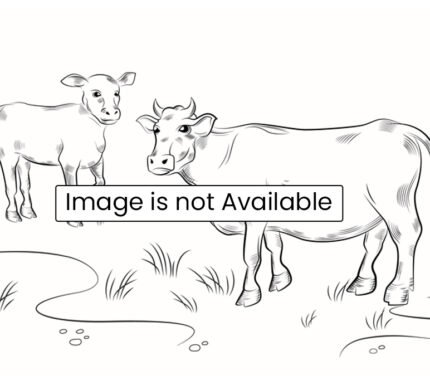Enepol
- Temperature:100.4°F to 102.8°F
- Milk:5 to 10 gallons
- Food:Silage, Hay, Pasture
- Pregnancy:Around 280-290 days
- Nationality:South America

General Information
Enepol is a breed of cattle that was developed in the 20th century in Argentina by crossing Hereford, Aberdeen Angus, and Shorthorn breeds. The name “Enepol” comes from the initials of the three breeds (Hereford: HE, Aberdeen Angus: NE, and Polled Shorthorn: POL) that were used to create the breed.
Enepol cattle are known for their adaptability to a wide range of environments and their ability to produce meat with excellent marbling and tenderness. They are also popular for their easy-going temperament, which makes them easy to handle and manage.
Enepol cattle are usually medium-sized, with bulls weighing around 800-900 kg and cows weighing around 500-600 kg. They have a reddish-brown coat with a white face and white markings on their legs and belly.
Where we find this cow to buy?
Enepol cattle is not a common breed of cattle and is mostly found in Colombia, where it was developed. As a result, it may be challenging to find Enepol cattle for sale outside of Colombia. However, there are some ways you can try to find Enepol cattle for purchase:
01. Contact local breeders : You can start by contacting breeders in Colombia or other countries where Enepol cattle are raised. They may be able to provide you with information about where to find Enepol cattle for sale.02. Check online marketplaces : There are several online marketplaces that may have listings for Enepol cattle for sale. You can search for these sites and check their listings.03. Attend livestock auctions : If you live in or near an area where livestock auctions are held, you can attend these events to see if any Enepol cattle are for sale.04. Contact breed associations : Contacting breed associations in Colombia or other countries where Enepol cattle are raised may provide you with leads on where to find Enepol cattle for sale.

How to increase milk production in Enepol
There are several ways to increase milk production in Enepol cattle, such as:
01
Providing a balanced diet with enough energy, protein, vitamins, and minerals is essential for milk production.
02
Breeding high-yielding cows with high-yielding bulls can increase milk production in offspring.
03
Proper milking techniques, including regular milking, complete milking, and proper milking intervals, can help maintain milk production levels.
04
Vaccination, deworming, and veterinary care are essential for milk production.
Medicine
Enepol is a crossbreed between the Charolais and the Nellore cattle breeds. The specific medical needs and treatments for Enepol may vary depending on the individual animal’s health condition and location. However, here are some common types of medicines that may be used for Enepol:
01
AntibioticsEnepol cattle may be treated with antibiotics to combat bacterial infections, depending on the type of infection and weight.
02
Parasite control medicationEnepol cattle may be susceptible to parasites, so parasite control medication may be given orally or applied topically.
03
VaccinesEnepol cattle can be vaccinated against diseases such as bovine viral diarrhea, infectious bovine rhinotracheitis, and leptospirosis.
04
Anti-inflammatory medicationEnepol cattle are given anti-inflammatory medication to reduce inflammation and pain associated with conditions such as arthritis and injury.
Pregnancy
This is the process of mating the female enepol with a male. The female enepol is typically in heat every 21 days and can be bred using artificial insemination or natural breeding.
When the gestation period is over, the female enepol will go into labor and give birth to a calf. It is important to monitor the cow during this time and provide assistance if necessary.
The female enepol goes through a long gestation period, requiring proper nutrition and veterinary care to ensure a healthy pregnancy.
Calving requires special care to ensure a healthy recovery, such as providing proper nutrition, monitoring for infection, and nursing properly.
Important!
Once the cow has fully recovered from calving, she can be rebred to continue the cycle of pregnancy and lactation.
Food
Enepol cattle, like all cattle, require a well-balanced diet to maintain optimal health and productivity. The diet of Enepol cattle should consist of high-quality forage, such as grass or hay, supplemented with grains and protein sources to meet their nutritional requirements.
Enepol cattle are primarily grazers, and access to good-quality pasture is important for their health and productivity.
Hay is a common source of forage for Enepol cattle when pasture is not available, or during the winter months.
Silage is a fermented feed made from crops such as corn, grass, or alfalfa, and can be a good source of nutrients for Enepol cattle.
Soybean meal, cottonseed meal, and distillers grains are important protein sources for Enepol cattle to support growth and maintenance.
Facts
Enepol cattle, also known as Enegro-Pintado or “painted black”, is a breed of cattle that originated in Brazil. Here are some facts about Enepol:
Enepol cattle originated in Brazil by crossing Nellore and Holstein cattle breeds.
Enepol cattle are known for their high-quality meat, which is tender, juicy, and flavorful.
Enepol cattle are mainly used for beef production, but they can also be used for milk production and as draught animals.
Enepol cattle are well adapted to hot and humid climates and can survive in areas with poor quality forage.
Enepol cattle are not primarily bred for milk production, but they can produce up to 12 liters of milk per day.
Enepol cattle are not endangered, but their population is small and efforts are being made to preserve them.
Enepol cattle have a fast growth rate, which makes them a good choice for beef production.
Enepol cattle are generally docile and easy to handle, making them a good choice for small farms.